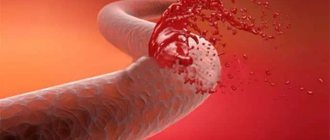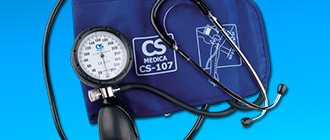25.11.2018
A.A.
(Last update: 01/23/2019)
There are contraindications. Specialist consultation required
Today, the problem of blood pressure surges is acute in medicine. A large number of people suffer from low levels. Decreased vascular tone or hypotension is diagnosed when the pressure does not exceed 100/40 mm. rt. Art. But, if a person has a blood pressure of 50 to 30 mm. rt. Art., it is necessary to urgently call an ambulance, as loss of consciousness and coma are possible.
Characteristics and description of the problem
Pressure 50/30 mm. rt. Art. – a serious health hazard. Such indicators can lead to loss of consciousness, coma, collapse and even death. A decrease in blood pressure is caused by circulatory disorders, which can cause brain hypoxia and seizures. In the absence of emergency assistance, a person’s life is at risk.
Do not self-medicate. Consult a specialist:
Hypotension is a companion for those people who have a thin build and pale skin. Most often, the pathology is characteristic of adolescent children and female representatives. People who suffer from hypotension often experience weakness, headaches, dizziness and other negative symptoms. Often such pressure indicators are observed in people suffering from varicose veins.
Often, pathology is a sign of some kind of disease, but can occur independently in acute or chronic form. Acute pathology often occurs in the form of a hypertensive crisis, when blood pressure drops to 50/30 mm. rt. Art. People with this disease should not stand up abruptly and remain in an upright position for a long period of time.
A drop in blood pressure to critically low levels leads to incapacitation of the body's functionality. In this case, the parasympathetic nervous system is activated, which is responsible for muscle tone, sleep and digestion.
You get promotional code OZON - 300 points for your first order. OZONAPIE1I (applied in the cart)
What symptoms might there be with such indicators?
Hypotensive patients are characterized by constant yawning; this is a reaction to lack of air; black spots may appear before the eyes. They need more time to sleep and have difficulty waking up. Due to poor blood supply to the muscles, pain sometimes occurs in the joints and ligaments, which disappear when the person begins to move actively. After all, as soon as it is possible to disperse the blood, the pressure returns to normal. Hypotonic people are sensitive to weather changes, climate change, and this manifests itself in headaches.
Often people with low blood pressure feel good; such indicators are normal for them. But you still shouldn’t relax, because over time, unpleasant sensations may appear. In addition, low blood pressure often indicates the presence of other dangerous diseases.
Characteristic symptoms:
- severe weakness;
- lack of air;
- noise in ears;
- spots before the eyes;
- dizziness;
- severe yawning;
- low temperature;
- pallor;
- cold sweat;
- tachycardia;
- severe headaches;
- nausea, vomiting;
- difficulty urinating when urine comes out in small portions.
Causes of low blood pressure
The physiological characteristics of the human body are a prerequisite for the development of hypotension. Also, the appearance of pathology can be provoked by the following diseases and conditions:
- Kidney pathologies;
- Prolonged stress and overwork;
- Exhaustion of the body;
- Anemia;
- Toxic shock;
- Disruption of the endocrine, nervous or cardiovascular system;
- Peptic ulcer;
- Lack of vitamins in the body;
- Dehydration;
- Impaired functionality of the respiratory system;
- Heredity;
- Long-term power loads;
- Changes in weather conditions;
- Heart failure;
- Heatstroke;
- Acute pain syndrome;
- Sudden change in body position;
- Taking antihypertensive drugs;
- Osteochondrosis;
- TBI.
If the pressure drops to 50/30 mm. rt. Art, this indicates the development of collapse - a dangerous condition that is accompanied by impaired circulation in vital organs, which can lead to death.
This condition can have several causes:
- Infectious pathology in acute form;
- Poisoning of the body;
- Vascular insufficiency;
- Development of a cancerous tumor;
- Pathologies of the nervous and endocrine systems;
- Acute adrenal insufficiency;
- Severe blood loss;
- Diseases of the abdominal organs in acute form;
- Heart attack.
Also pressure 50/30 mm. rt. Art. may be a sign of shock - a life-threatening condition accompanied by disturbances in the central nervous system, blood circulation, respiration and metabolic processes. In this case, the heart muscle is not able to push blood through with the required force, which leads to disruption of the activity of all organs and systems. First of all, the functionality of the kidneys and brain is impaired, which can cause death.
Each of these conditions requires immediate medical attention. If it is absent, the mortality rate is between eighty-five and one hundred percent.
In teenagers
Hypotension is often diagnosed in adolescents; this is due to hormonal changes in the body. Indicators depend on gender, age, emotional state. An examination is necessary to rule out serious disorders such as electrolyte imbalance, heart disease and kidney disease.
Features of low blood pressure in teenagers:
- The lower readings at 50 indicate a violation of the tone of the vascular walls.
- The upper readings at 50 indicate severe stress and strain.
In children under 7 years of age, readings of 80 to 50 are the norm, if there is no deterioration in general health.
Most Common Causes of Low Blood Pressure
Common causes of a drop in blood pressure are:
- A congenital feature of the body occurs in 7% of cases.
- Heart failure, which often occurs due to myocarditis, endocarditis, and also as complications of influenza and sore throat.
- VSD of hypotonic type. In this case, blood pressure often fluctuates due to the active work of the adrenal glands.
- Exacerbation of stomach ulcers or pancreatitis.
- Depression.
- Visiting a Russian bath, sauna or thermal baths.
Symptoms of pathology
Reduced blood pressure to 50/30 mm. rt. Art. accompanied by symptoms that are not difficult to notice. First of all, this is due to a circulatory disorder in the brain. As a result, tinnitus, weakness, headache, dizziness, darkening of the eyes, and frequent yawning appear.
Consciousness may become clouded, body temperature also decreases, the skin becomes pale and the nasolabial triangle turns blue, cold sweat appears, and tachycardia develops. Nausea and vomiting often occur.
As a result of a decrease in vascular tone, pathologies of the heart and blood vessels, chest pain, palpitations, lack of air, and numbness of the extremities may appear.
In severe cases, the following symptoms may develop:
- Cooling of the skin;
- Blueness of lips;
- Marble pattern on the skin;
- Dyspnea;
- Fear of death;
- Loss of consciousness;
- Death.
Clinical picture
The pathology is characterized by symptoms of impaired cerebral hemodynamics and hypoxia of other organs:
weakness, fatigue, apathy, drowsiness;- weather sensitivity;
- absent-mindedness, memory impairment;
- emotional lability, irritability;
- shortness of breath on exertion;
- tachycardia;
- dizziness, syncope (fainting);
- headache (usually in the frontal and temporal parts);
- pale skin, hyperhidrosis (sweating).
Low pressure danger
When blood pressure decreases to 50/30 mm. rt. Art. it is necessary to immediately provide emergency assistance to the victim. Otherwise, a person may lose consciousness, fall and suffer a head injury, including a concussion.
With such blood pressure, the risk of strokes increases, as the tone of the coronary vessels is disrupted, as well as the formation of blood clots. The brain does not receive enough oxygen, which affects all organs and systems of the body.
The consequences of frequent low blood pressure are cumulative. During crises, the vessels contract and become toned, but such phenomena, which occur frequently, lead to the development of hypertension in the future. This is due to the structural restructuring of blood vessels. In this case, a slight increase in blood pressure will be tolerated by the person as a hypertensive crisis. In this case, the doctor must carefully select stabilizing drugs, otherwise there will be a sharp drop in blood pressure, collapse and death.
Complications and consequences
Blood pressure 50/30 mm. rt. Art. – a dangerous condition, which indicates the development of collapse. Collapse is a drop in blood pressure, impaired circulation in organs and tissues, vascular insufficiency, and cerebral hypoxia. It requires immediate treatment, otherwise death occurs.
If a person stays for a long time with low blood pressure, there is a risk of developing cardiogenic shock. It will develop rapidly. There will be pain in the heart area, arrhythmia, tachycardia, pale skin, blue lips. In 70% of cases, a stroke develops, and seven out of ten people die due to thrombosis of the arteries of the brain or heart.
conclusions
Low blood pressure is rare in people over 50 years of age. The main cause of the phenomenon is considered to be genetic predisposition. This condition (sometimes caused by coronary artery disease, or impaired renal function) can be accompanied by a sharp disruption of cerebral blood supply, and therefore requires close attention.
Treatment of hypotension in older people includes the use of medications such as caffeine and herbal tonics. Physiotherapeutic measures are also recommended for the patient.
First aid
If a person's blood pressure has dropped, the following measures should be taken:
- Call an emergency team;
- Lay the victim so that his head is higher than his feet;
- Give a person to drink a painkiller if there is severe pain in the head;
- Provide fresh air.
Do not give the victim alcoholic beverages, coffee and caffeine-based drugs, as well as medications that increase blood pressure without a doctor’s prescription. Otherwise, a sharp increase in blood pressure, development of collapse and death is possible.
A person with a blood pressure of 50/30 mm. rt. Art. must be taken to a hospital where he will receive emergency care. Self-medication is unacceptable.
In the elderly
In elderly patients, a different picture may appear: the lower pressure is high, and the upper pressure is slightly elevated. This is due to the fact that blood vessels lose elasticity with age, and less blood enters them when the heart contracts. If the indicators are 50 to 50, treatment and sleep for at least 10 hours are necessary. Hypotonic patients should not get out of bed abruptly in the morning, so as not to provoke a surge in blood pressure.
Constant consumption of coffee can cause a large dilation of blood vessels, and the pressure will drop even more.
Emergency medical care
Emergency treatment methods will depend on the cause of the drop in blood pressure to low levels. The main thing is to correctly establish the cause of the pathology that led to this condition. If there is bleeding, it must be stopped; in case of intoxication, toxins are eliminated from the body, brain hypoxia is eliminated, etc. In some cases, doctors perform transfusions of blood components or blood substitutes.
When blood pressure drops to 50/30 mm. rt. Art. Doctors administer Prednisolone to a person; the dosage is calculated individually in each specific case. If no effect is observed, Metasone, adrenaline, norepinephrine or dopamine are administered. For acidosis, sodium bicarbonate solution is administered.
Therapy
Usually when blood pressure drops to a blood pressure level of up to 50/30 mm. rt. Art. use "Cordiamid", "Ephedrine" or "Tonocard". If necessary, resuscitation measures are carried out. In order for a person to feel good, it is necessary not only to increase blood pressure, but also to eliminate the cause of this pathology. This is the only way the prognosis for recovery will be good.
Doctors use the following drugs as medical treatment:
Adaptogens: Pantocrine, Saparal, lemongrass, ginseng. They help increase the body's ability to resist external influences. These drugs have a mild effect on the body.
Analeptics: “Cordiamin”, “Etimizol”. They have a strong effect on the brain, normalize breathing and blood circulation, and stimulate the central nervous system.
Alpha adrenergic agonists: “Gutron”, “Methazon”. The drugs are used to quickly normalize blood pressure.
The choice of drugs for the treatment of hypotension should be made by the attending physician. It depends on the causes of low blood pressure, the patient’s condition, the individual characteristics of the body and other factors. But all drugs have a sufficient effect that can normalize blood pressure.
Forecast
It is important to promptly provide assistance to a person whose blood pressure has dropped to low levels. Otherwise, cardiogenic shock may develop, a common cause of death. Treatment of hypotension should be comprehensive; the choice of treatment tactics should be made by a doctor.
Preventive actions
To prevent blood pressure from falling to 50/30 mm. rt. Art., it is necessary to lead a healthy lifestyle, eliminate bad habits, and eat healthy food.
It is important to promptly treat cardiovascular pathologies and treat the nervous system if necessary. Doctors recommend that hypotensive patients engage in physical activity to maintain vascular tone and normalize sleep and wakefulness.
At the first symptoms of low blood pressure, you should call an ambulance.











